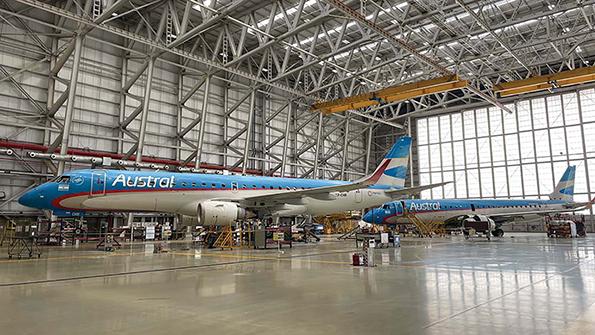
The airline’s newest hangar, pictured with two Austral Embraer 190s, can hold four narrowbodies and one widebody at once.
Aerolineas Argentinas has made the best of challenging economic times over the last decade to transform itself into a more competitive airline. The outcome is a much more streamlined fleet, better on-time performance and a stronger MRO business that plans to expand its third-party maintenance services.
Aerolineas merged with Austral in 2020, which required it to “change the way we work,” says Pablo Ceriani, president of Aerolineas Argentinas. While the airline’s MRO activities were one of the hardest parts to merge, it forced a reevaluation of processes. The transformation was successful, spanning parts storage, backshops, IT and day-to-day work in the airframe and engine shops. “We see the region’s MRO needs” and “we can now present our expertise to be part of the solution,” Ceriana says.
The company unveiled the new branding—Aerolineas Argentinas Tecnica—at MRO Latin America in late February and is “analyzing what the market in the region is looking for,” including engines, landing gear, components and airframe maintenance, says Diego De Risio, Aerolineas Argentina’s MRO manager.
As part of this journey, the airline MRO is trying to improve turnaround times (TAT). It is engaged in “a never-ending game to reduce TAT and be competitive in the region,” De Risio says. One priority is working with Boeing to reduce TAT for 737NG landing gear overhauls because the shop “is going to face a very aggressive plan in 2024 and 2025” for the gear’s scheduled maintenance, he notes.
Aerolineas took delivery of about 15 737s in two years. Landing gears require overhaul every 10 years, so the airline will be hit with several shipsets in 2024-25. “That is why I have to reduce the gap by almost 50%,” he says.
The 737 landing gear overhauls take 90 days; the goal is to reduce that to 60 days. De Risio expects the shop to hit 75 days by the end of the year and 60 days in the first quarter of 2024.
While that work will be for parent company Aerolineas Argentinas, he says achieving a competitive TAT for landing gear overhauls will also put it in a better position to gain third-party work for the same service.
Engine shop capabilities include select hospital visit services for CFM International CFM56-5, General Electric CF34-10E and CF6 and Pratt & Whitney PW4000 models, but it plans to add CFM56-7B performance restoration services by the end of 2023, De Risio says.
The airline is working with “a big player of the industry” on the CFM56 service expansion and plans to add Argentinian National Civil Aviation Administration and FAA certification by the end of this year, De Risio says. He expects European Aviation Safety Agency certification to follow in the first quarter of 2024.
The MRO shop expects to complete 12 CFM56 overhauls per year initially, but De Risio says that could increase to 18-20 per year by 2025.
Aerolineas is analyzing additional component maintenance offerings for itself and others, particularly those who operate 737NGs and Airbus A330s, which the Argentinian airline flies. “We have a lot of experience to share,” De Risio says, noting that “we have to be competitive” on TAT and costs—especially because some regional airlines it hopes to gain as customers are low-cost carriers, such as Gol. “We are working very hard on this,” he adds.
Its proximity to other South American carriers could help sweeten the business case: “I think the logistics costs help us because we are very close,” he notes.
Aerolineas Argentinas Tecnica only provides heavy maintenance for its parent airline, but it is working to reduce TAT for airframe checks to release slots for third parties. By 2024, it hopes to offer a narrowbody production line exclusively for third parties. De Risio says the MRO is in talks with airlines in the region about this.
Its newest hangar, Hangar 5 at Buenos Aires Ezeiza International Airport, can accommodate four narrowbodies and one widebody simultaneously.
